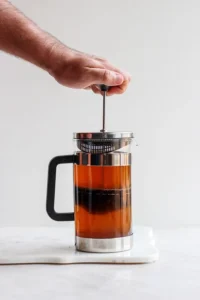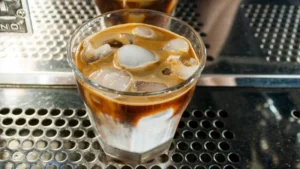What Is Cold Brew Coffee
Cold brew coffee is made by steeping coffee grounds in cold or room-temperature water for an extended period, usually between 12 and 24 hours. The process extracts flavor slowly, producing a drink that is smooth, low in acidity, and naturally sweet. Unlike iced coffee, which is brewed hot and then chilled, Cold extract coffee never meets heat, allowing its oils and sugars to remain intact.
Cold brew coffee has gained popularity for its mild taste and versatility. It can be served straight, with milk, or as the base for refreshing coffee-based beverages. Its long extraction process highlights the deep, rich tones of coffee beans without the bitterness that sometimes appears in hot brewing.
History of Cold Brew Coffee
The history of Cold extract coffee stretches back several centuries. The earliest records point to 17th-century Japan, where Kyoto-style cold brew coffee was developed. The Japanese technique involved slow dripping cold water over coffee grounds, creating a clear, refined flavor that emphasized balance and sweetness.
In the 1960s, the method gained attention in the United States through the Toddy brewing system. This approach simplified Cold extract coffee preparation for home use and coffee shops. Since then, it has grown into a worldwide favorite, especially among those who prefer less acidic and smoother coffee options.
Today, cold brew coffee is a common feature in cafés, grocery stores, and home kitchens. Its popularity continues to rise because it caters to a range of tastes — strong, mild, creamy, or bold — without losing its signature smoothness.
How Cold Brew Coffee Differs from Iced Coffee
Many people confuse cold brew coffee with iced coffee, but they are quite different. The main distinction lies in the brewing method.
Brewing Process
Cold brew coffee is made by steeping coarsely ground coffee in cold water for many hours. Iced coffee, on the other hand, is brewed hot and then poured over ice. The hot brewing process extracts more acidity and bitterness, while cold brewing creates a sweeter, mellower taste.
Flavor and Texture
Cold brew coffee tastes naturally sweeter and has a thicker, velvety mouthfeel. Iced coffee is sharper, lighter, and often needs sugar or milk to balance the acidity. Cold brew coffee’s lower temperature extraction prevents bitterness, allowing subtle chocolate or caramel notes to shine.
Caffeine Content
Cold extract coffee often has higher caffeine concentration because the ratio of coffee to water is stronger. However, caffeine levels vary depending on the beans and steeping time.
Benefits of Cold Brew Coffee
Cold brew coffee offers several benefits beyond taste. These advantages make it a favorite among coffee lovers who seek convenience, health benefits, and great flavor.
Lower Acidity
Cold brew coffee is gentler on the stomach due to its reduced acidity. This makes it suitable for those who experience discomfort from hot coffee. The slow brewing process extracts fewer acidic compounds, resulting in a smoother drink.
Natural Sweetness
The gentle extraction process allows Cold extract coffee to retain the natural sweetness of coffee beans. Many people find that it needs little or no added sugar, making it a healthier option.
Long Shelf Life
Cold brew coffee can be stored in the refrigerator for up to two weeks without losing flavor. Its concentrated form makes it easy to dilute and customize.
Convenience and Versatility
You can make a batch of Cold extract coffee ahead of time and enjoy it throughout the week. It can be mixed with milk, flavored syrups, or even tonic water for creative coffee drinks.
How to Make Cold Brew Coffee at Home
Making cold brew coffee at home is simple. With minimal equipment, anyone can prepare a smooth, refreshing batch.
Ingredients You’ll Need
- Coarsely ground coffee beans (preferably medium to dark roast)
- Filtered cold or room-temperature water
- A jar or pitcher with a lid
- A fine mesh strainer or coffee filter
Brewing Ratio
A common ratio for Cold extract coffee is 1 cup of coffee grounds to 4 cups of water. This creates a concentrate that can be diluted with milk or water to taste.

Step-by-Step Process
- Combine coffee grounds and water in your container. Stir gently to ensure even saturation.
- Cover the jar and let it steep for 12–24 hours at room temperature or in the refrigerator.
- Strain the mixture through a fine filter or cheesecloth into a clean container.
- Store the finished cold brew coffee in the refrigerator for up to two weeks.
To serve, pour over ice and dilute with milk or water according to your preference. The result is a rich, mellow drink that’s ideal for warm days or as a morning pick-me-up.
Choosing the Right Coffee Beans for Cold Brew Coffee
The quality of your cold brew coffee starts with the beans. Since the brewing process highlights subtle sweetness, choosing the right coffee beans is essential.
Best Coffee Bean Types
Medium to dark roasts are generally preferred for cold extract coffee. These beans create a fuller body and stronger flavor. Light roasts can work too, offering a brighter, fruitier taste, but they may lack the deep richness cold brew coffee is known for.
Grind Size
Always use coarsely ground beans. A fine grind can make the Cold extract coffee cloudy and over-extracted, resulting in bitterness. Coarse grounds allow slow, even extraction.
Freshness
Freshly roasted beans make the biggest difference. Coffee beans start losing aroma within weeks, so use them soon after roasting for the best flavor.
Cold Brew Coffee Concentrate
Cold brew coffee can be prepared as a concentrate that you dilute before drinking. This version is stronger and perfect for storing in the fridge for quick use.
How to Make the Concentrate
Use a higher coffee-to-water ratio — around 1 cup of coffee to 2 cups of water. After steeping for 12–18 hours, strain and refrigerate. When serving, mix one part concentrate with one or two parts water or milk.

Ways to Use Cold Brew Coffee Concentrate
- Serve over ice with milk or cream
- Add to smoothies for a caffeine boost
- Use in desserts or baking recipes for flavor
- Mix with sparkling water for a refreshing twist
Cold brew coffee concentrate offers flexibility and can be customized to suit personal taste.
Health Benefits of Cold Brew Coffee
Cold brew coffee not only tastes good but also offers potential health benefits when enjoyed in moderation.
Supports Energy and Focus
The caffeine content in Cold extract coffee boosts alertness and mental clarity. The slower absorption from cold beverages provides sustained energy without a sharp crash.
Rich in Antioxidants
Cold brew coffee retains antioxidants like polyphenols that may reduce inflammation and support heart health. These compounds are naturally preserved in cold extraction.
Better for Digestion
People sensitive to acidic foods often find Cold extract coffee easier to digest. The lower acidity level means less irritation for the stomach and teeth enamel.
Hydration Support
Because it’s brewed with water and often served chilled, Cold extract coffee helps keep you hydrated, especially during hot weather.
Storing Cold Brew Coffee
Proper storage ensures your cold brew coffee retains its flavor. Keep it in a sealed glass container in the refrigerator. Avoid plastic bottles that can absorb odors. Always store the concentrate separately and dilute it only when serving.
Cold brew coffee can stay fresh for up to 10–14 days. After that, its flavor begins to fade. If you notice a sour or stale smell, it’s time to make a fresh batch.
Common Mistakes When Making Cold extract coffee
Even though Cold extract coffee is simple to make, small mistakes can affect the flavor. Here are common issues to avoid:
- Using finely ground coffee, which can make the brew muddy
- Steeping for too little time, leading to weak flavor
- Using poor-quality water or stale coffee beans
- Forgetting to store it properly
Correcting these details ensures your cold brew coffee is consistently smooth and flavorful.
Cold Brew Coffee FAQ
1. How long should I steep cold brew coffee?
The ideal steeping time is between 12 and 24 hours. Steeping for less time produces weak flavor, while overstepping can cause bitterness.
2. Can I make Cold extract coffee without a special maker?
Yes, all you need is a jar or pitcher and a fine filter. A French press also works well for brewing Cold extract coffee at home.
3. How strong is cold brew coffee compared to regular coffee?
Cold extract coffee is usually stronger in caffeine and flavor concentration. You can dilute it with water or milk to suit your taste.
4. What’s the best coffee-to-water ratio for Cold extract coffee?
For standard strength, use one part coffee to four parts water. For a stronger concentrate, use one part coffee to two parts water.
5. Can I heat cold brew coffee?
Yes, you can warm it gently without boiling. Heating Cold extract coffee changes its profile slightly but keeps its smooth taste.
Final Thoughts on Cold Brew Coffee
Cold brew coffee stands out for its mellow flavor, versatility, and simplicity. It’s easy to prepare, stores well, and offers a satisfying alternative to hot coffee. With the right beans, grind size, and patience, anyone can make a barista-quality Cold extract coffee at home.
Whether you enjoy it black, with milk, or as a sweet treat, cold brew coffee delivers a refreshing and balanced experience. Its growing popularity is a sign of how much people appreciate smoother, less acidic coffee. Start with fresh beans, use cold water, and let time do the work — the result is worth it.
